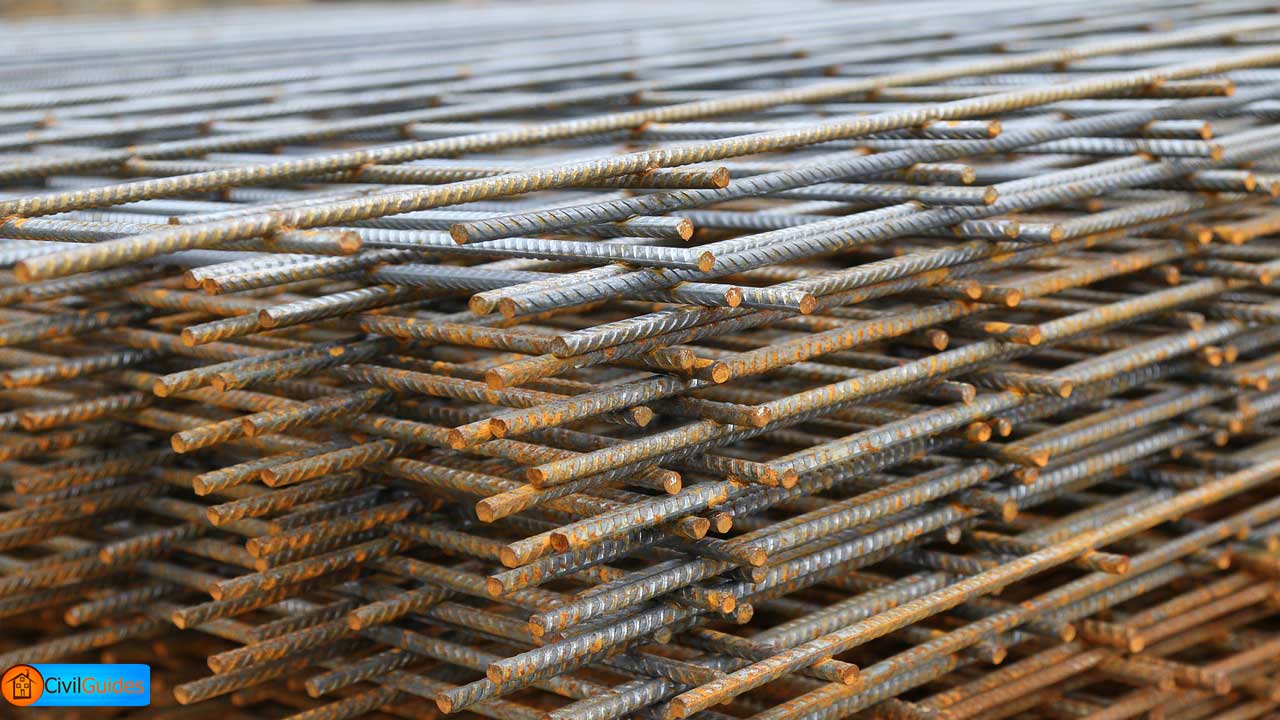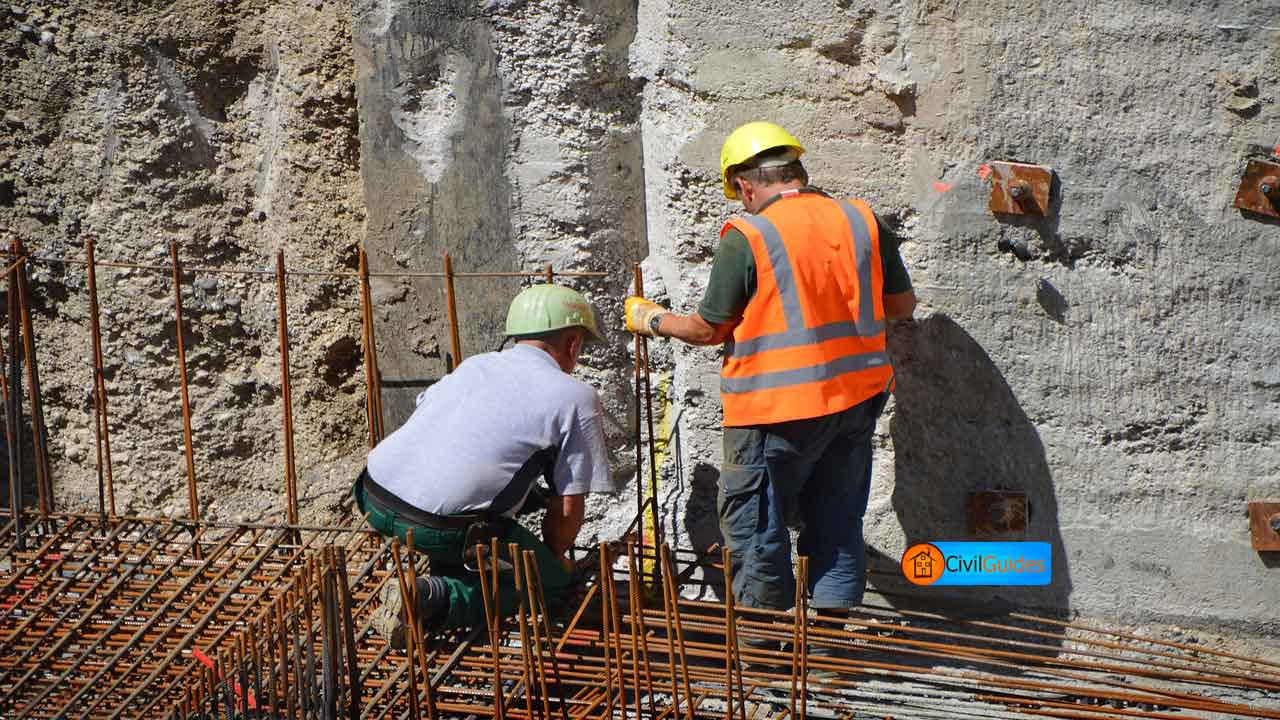Reinforced Cement Concrete;
Reinforced cement concrete (R.C.C) is the combination of ordinary concrete with the reinforcement to increase its compressive and tensile strength to a great extent.
Concrete is a versatile material for modern construction which is prepared by mixing well-proportioned quantities of cement (even lime in some cases), sand, crushed rock or gravel, and water.
It has been used from foundations to the rooftops of buildings, in the construction of highways roads traffic, and hydro-power tunnels, irrigation canals, drains, and all other conceivable structures.
So, Let’s Start.
Purpose of Reinforcement in Concrete.
As you know that, Concrete has a very high compressive strength, but it is low in tensile strength.
Thus, when only the compressive loads are acting on the concrete surface, then there is no need of using reinforcement in it.
But where tensile forces are also involved, as in, beams and slabs, there is a very high risk of its failure when plain concrete is used.
Steel, however, as we know, has a very high tensile strength (and also have good compressive strength).
Hence, when these two (concrete and steel) are combined together,
a material of construction is obtained that is capable of withstanding all the three types of forces likely to act upon a structure, i.e., compressive loads, tensile stresses, and shear forces.
Such a material is known as Reinforced Cement Concrete.
It has proved extremely useful and reliable in engineering construction.
Nature of Reinforced Cement Concrete:
The main principle in the preparation of the reinforced cement concrete is to make a structural material in which
(i) Steel serves the purpose of bearing the main tensile stresses;
(ii) concrete bears the main compressive forces, both acting in complete unison;
Concrete and steel are compatible in following aspects:
(i) Concrete is basically alkaline in nature, (the principal component being Calcium hydroxide) and this prevents rusting of the steel reinforcement used within it;
(ii) The bond or ‘grip’ between the steel and concrete is established easily;
(iii) The coefficient of thermal expansion of concrete is almost identical with that of steel.
This prevents the risk of cracking due to expansion at different rates.
Types of Reinforcement used in R.C.C:
Reinforcement used in concrete is principally made of steel of different types.
Further, it may be made in required shape and volume.
Some common types of reinforcement are:
(i) Mild Steel Bars:
These come in various diameters and are required to possess a characteristic strength in tension which is specified in relevant codes.
This steel bar used as reinforcement can be commonly bent easily without cracking at the bends.
(ii) Hot Rolled Bars and Cold Worked Bars:
They are specially prepared reinforcements.
The first type has a characteristic strength in tension which is almost double than that of mild steel bars.
Further, as these come commonly in thick sections.
They can be bent by heating (up to 100°C) without developing any defects.
This is not possible with the ordinary mild steel bars.
Similarly, the cold worked steel bars come in twisted or stretched forms having elongated ribs or such structures along their length.
They also have a much higher characteristic strength of the order of 425 N/mm2 against 250 N/mm2 for mild steel bars.
Such bars may not be heated for bending and re-bending.
(iii) Steel Fabric:
This is made from a variety of bars and wires.
These may include plain round wires, indented and deformed wires, deformed steel bars of cold-worked type.
The mesh from such wires is made by welding together straightened lengths very carefully and strictly in accordance with the specifications.
Otherwise, the mechanical properties of reinforcement may be affected adversely.
Placement of Reinforcement:
It requires very complex and careful design considerations for each member of reinforcement concrete.
Thus, the size, shape, spacing, and location of reinforcement will be entirely different in a slab or beam or a column.
In beams, for example, steel bars may be required more in the lower sections and in fixed beams, in the end, sections as well where the tensile stresses are most effective.
The top section of the beam may need no reinforcement.
The horizontal reinforcements are often tied up with square stirrups at suitable intervals.
These stirrups also provide additional strength to the Reinforced Cement Concrete against shearing stresses.
The reinforcement requires the minimum prescribed covering of concrete.
The covering is essential to protect the reinforcement from deterioration under attack from weathering agencies and also from casual fires.
The concrete covering varies from 25 mm to 80 mm depending on the environment in which the RCC member has been placed.
It is also important that the reinforcement must be clear of rust, dust, and grease at the time of placement.
This will ensure a better bond between concrete and reinforcement.
Advantages of Reinforced Concrete (RCC).
There are 100s of advantages of Reinforced Concrete, but here we will discuss some important advantages of Reinforced Concrete.
(i) Structures made from Reinforced Concrete are durable.
(ii) It has a high compressive strength (due to concrete).
(iii) It has a high tensile strength (due to reinforcement).
(iv) It is resistant to fire and other climate changes.
(v) Easily available almost anywhere in the world.
(vi) Too much expertise is not required for working on it, normal skilled labor can also do it.
(vii) It can be molded in any form, shape.
(viii) It can be used in any part of the structure i.e., from foundation to the top roofing.
(ix) Repairing cost is almost nil.
(x) It is more economical compared to other materials.
Final Words.
Thanks! for reading. Don’t forget to share it.
Read Also:


thankyou Khan,indeed you are making a way for us.
i am very satisfied by your not and i like to say thank you. but i have a question what is the importance &use of codes in reinforced concrete design?
fantastic
Thank u for information
Thanks for this very much wish I can have a job in CIVILSEEK.com am in Cameroon
Nice information a civil engineer knowledge…….thank dear.
What is the name of the author and the publish date of the article? Your reply is greatly appreciated.
I really like your information about reinforced cement concrete